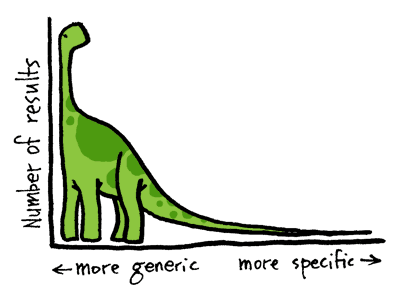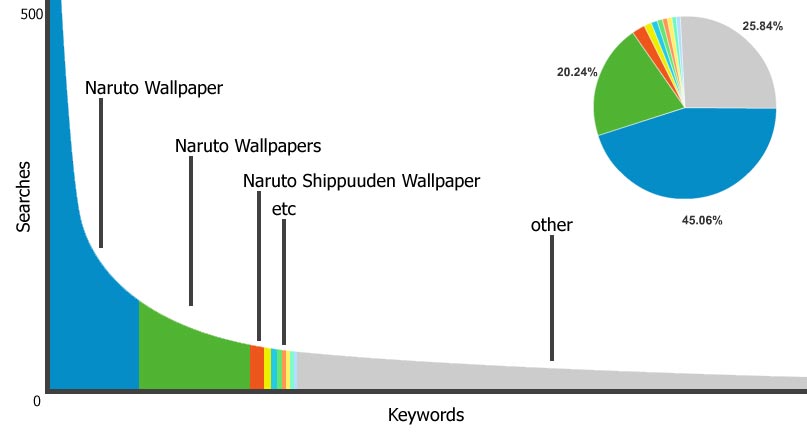Keywords can be split into two main groups, short tail keywords and long tail keywords, or broad keywords and narrow keywords. The term ‘long tail’ was coined by Chris Anderson and is used to describe the strategy of targeting less-competitive niche markets rather than the hugely competitive broad keywords. A long tail keyword is something like ‘Small Business Web Design’ while a short wail keyword is something like ‘Web Design’.
 Long tail keywords are those three and four keyword phrases which are very, very specific to whatever you are selling. You see, whenever a customer uses a highly specific search phrase, they tend to be looking for exactly what they are actually going to buy. In virtually every case, such very specific searches are far more likely to convert to sales than general generic searches that tend to be geared more toward the type of research that consumers typically do prior to making a buying decision.
Long tail keywords are those three and four keyword phrases which are very, very specific to whatever you are selling. You see, whenever a customer uses a highly specific search phrase, they tend to be looking for exactly what they are actually going to buy. In virtually every case, such very specific searches are far more likely to convert to sales than general generic searches that tend to be geared more toward the type of research that consumers typically do prior to making a buying decision.
You may be wondering why anybody would want to target hundreds or thousands of keywords which bring only small traffic. Well the answer is simply that there is less competition so you can rank on the first page of Google for long tail keywords far easier than ranking for short tail keywords. Yes, they don’t bring a lot of traffic separately but if you target lots of long tail keywords you can get lots of easy traffic. Not everybody is capable of ranking highly for highly competitive keywords but anybody(!) can rank for long tail keywords.
Here’s a specific example. Let’s say your site sells guided mountain climbing tours in California. At first, you might consider targeting a generic phrase like travel. After all, an adventure tour is generally the type of excursion people like to participate in while traveling on vacation.
However, if you tried to go after that phrase, you’d be facing direct competition from big sites like Yahoo.com, CNN.com and Travelocity.com. It’s unlikely you’d be able to knock any of those sites out of the top ten unless you’re willing to invest a pile of money and a mountain of time.
But, even more importantly, travel isn’t the best phrase for you to target anyway. That’s because many people who search using that phrase are looking for items such as plane tickets, ocean cruises or just doing very general research on where they might like to go. They’re probably not saying to themselves…
Of course this suggests that you should be creating pages that zero in on snagging searchers who use long tail keywords. And, since there are potentially so many different long tail combinations that searchers may use to buy what you offer, that means you’ll likely be creating more pages.
The goods news is that Google likes sites that have more pages. It makes the site look more substantial, more natural, and even more real in the eyes of the world’s most popular search engine. Bear in mind that your “unique” pages need only be variants of your main offering(s) but focused on a specific long tail niche.
Therefore, each and every page will have a unique title, description meta tag, h1 header tag, and body content that emphasizes your offering by using the long tail keyword that you choose for each specific page. It isn’t rocket science, but it sure does work well to snag consumers at the optimum stage of the buying process!
So, instead of focusing on just two or three highly competitive general keywords, target the dozens or even hundreds of easy-to-rank-for long tail keywords.
Also bear in mind, however, that the downside of focusing too much effort on the long tail is, if you target phrases which are too specific, you might not get enough traffic to sustain your business. That’s why it’s best to have:
- a few pages sending you large amounts of less targeted traffic, and
- a large number of pages with each sending you small amounts of highly targeted traffic.
But overall, it’s best to think of it this way; would you rather rank for one keyword which sent you 1000 visitors a day or 200 key phrases, half of which sent you 1 buyer a day?
After you do the math you’ll see that 100 buyers are much better than 1000 site visitors who are only doing research. And there is no question that the use of ultra-specific keywords demonstrate a greater intent to buy on the part of the customer. This simply leads to more sales which is, of course, what you are really after.




